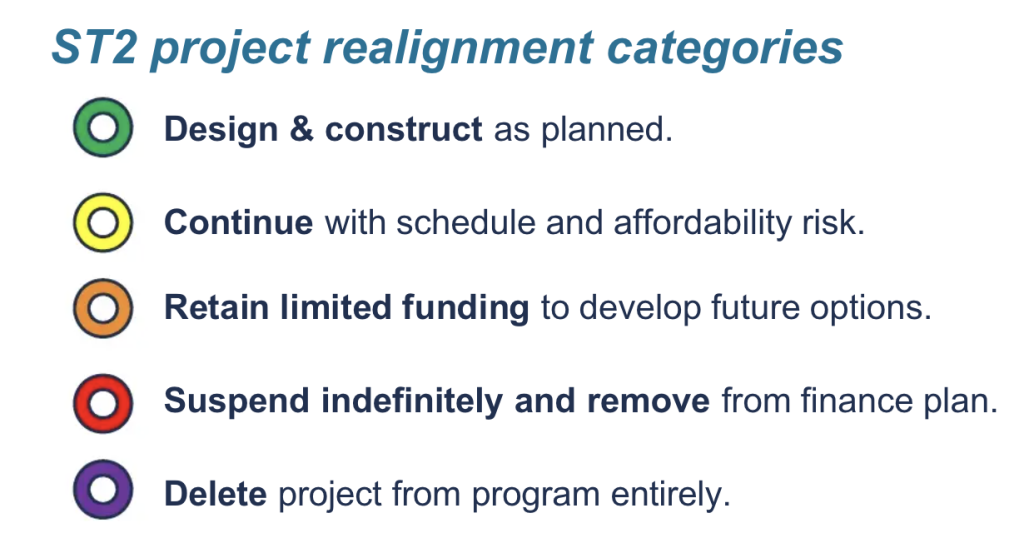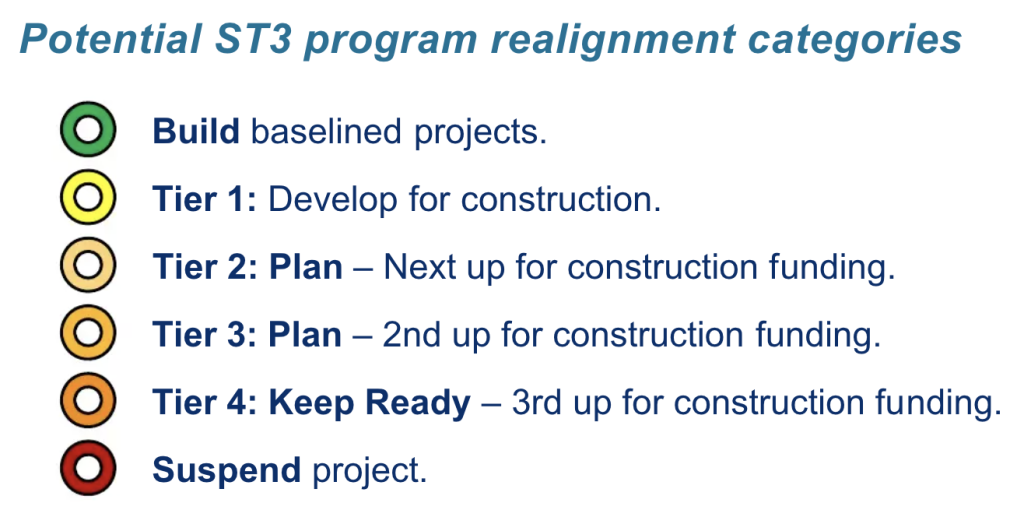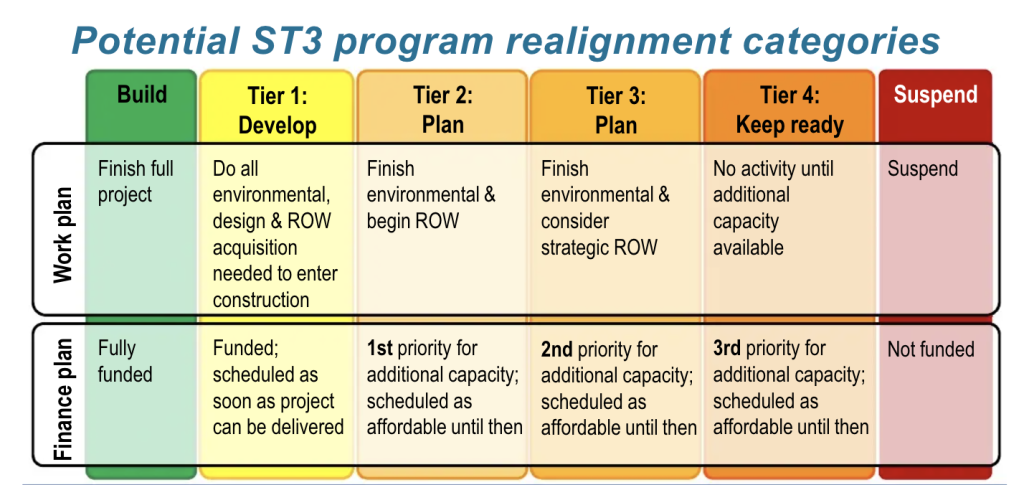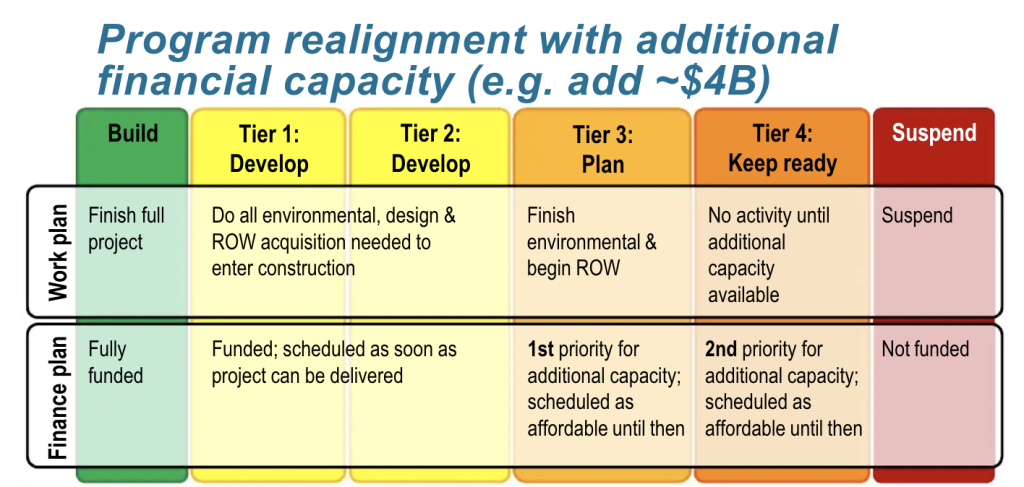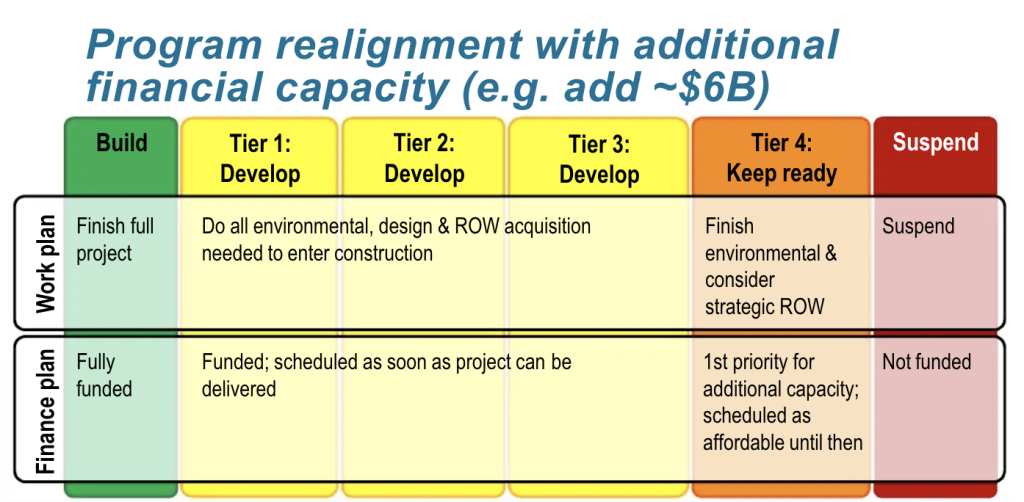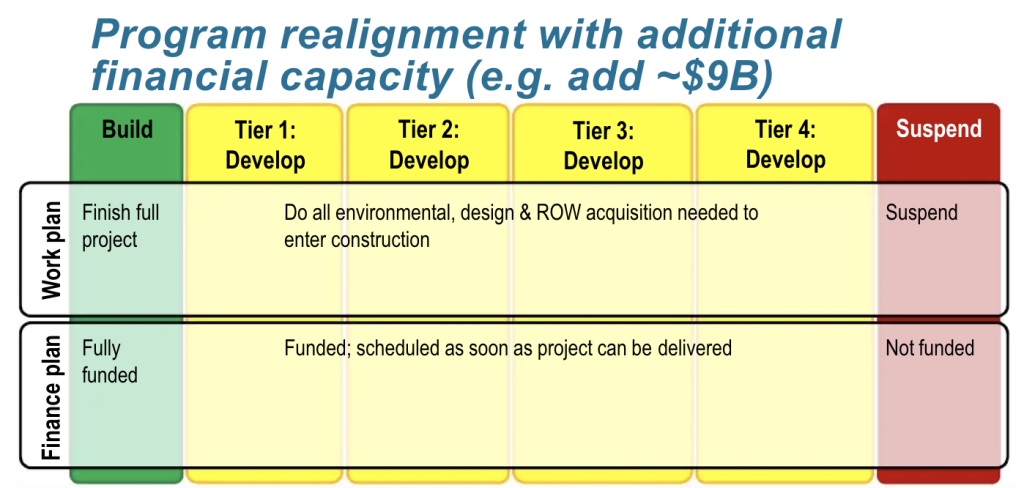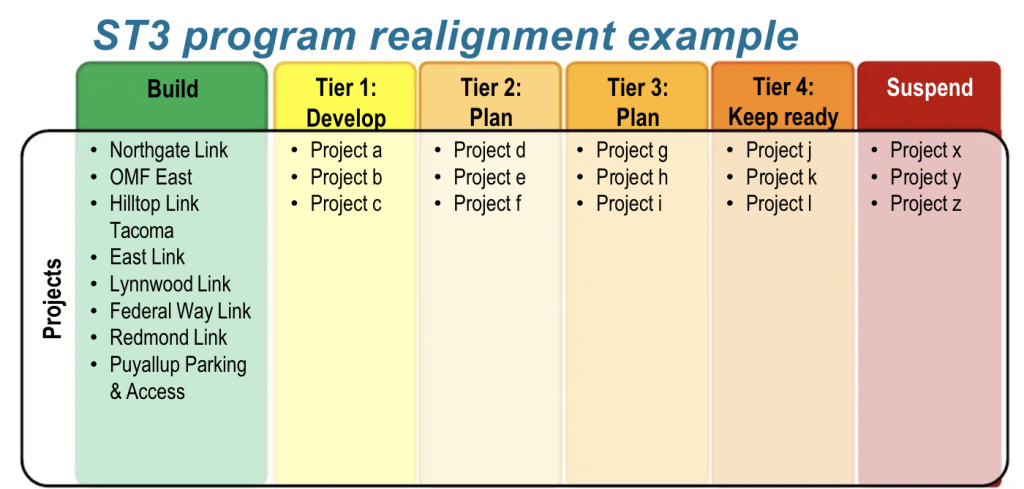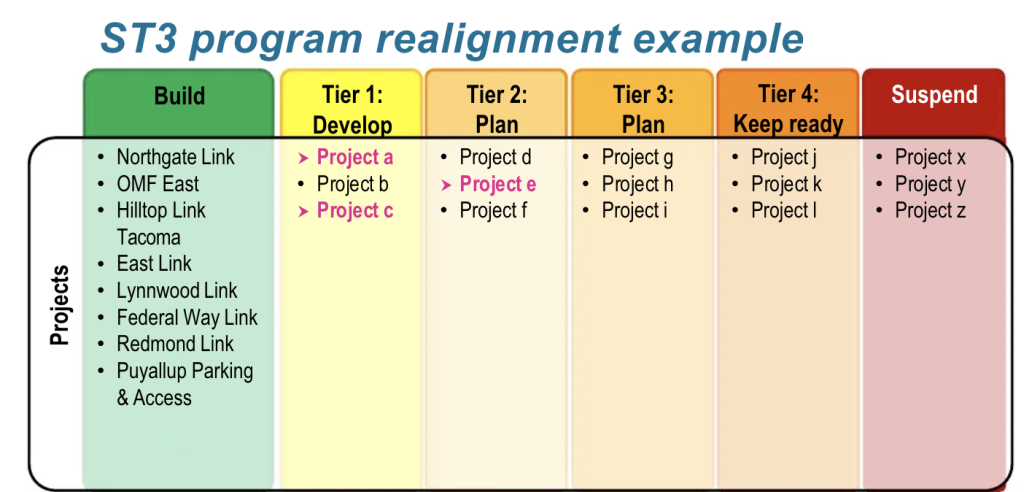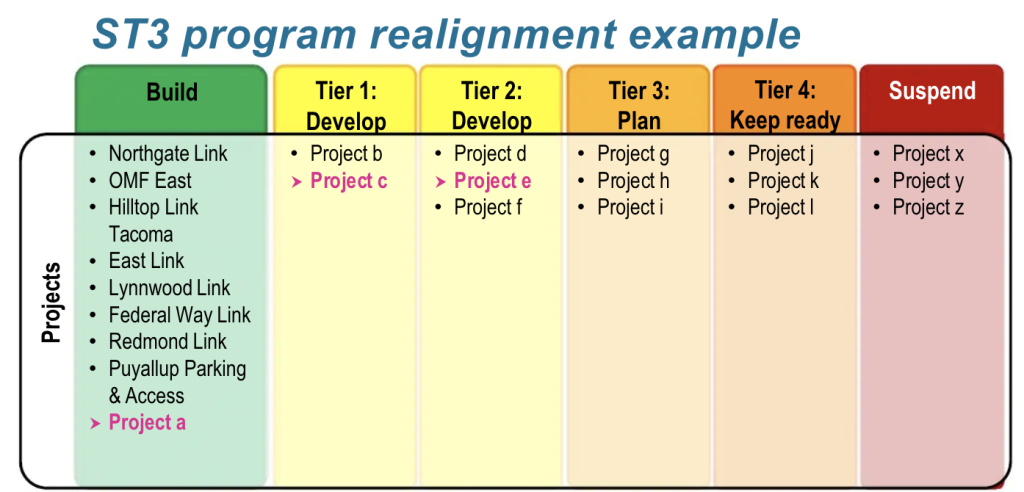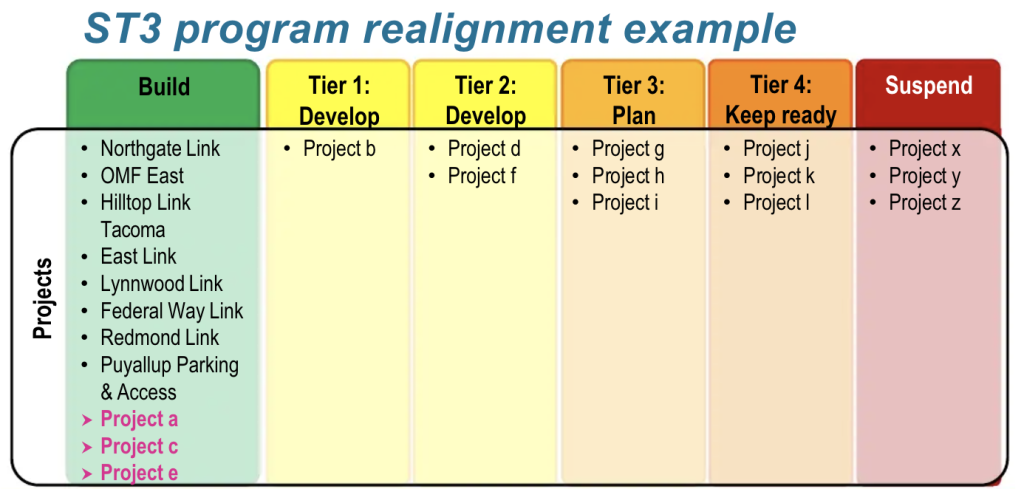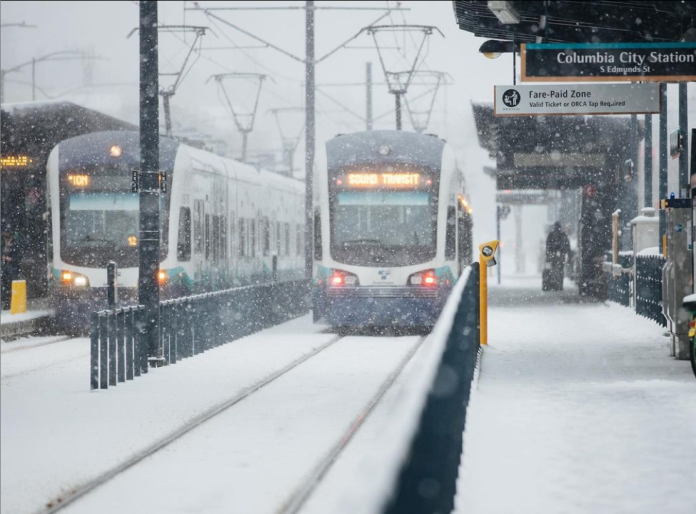
How Sound Transit will realign its capital expansion program to address an $11.5 billion affordability gap through 2041 still remains uncharted. But agency staff are working through a framework development process to aid in decision-making. The framework could take cues from the previous realignment process for Sound Transit 2 when the agency had to cut and delay projects because of funding shortfalls from the Great Recession. However, Sound Transit appears poised to only suspend projects at worst, not scuttle them entirely like the 2010 realignment process had done. An adopted framework will also work in tandem with the eight criteria and various financial capacity scenarios to develop realignment alternatives.
At a board meeting last month, agency staff provided hypothetical scenarios for realignment. Several different criteria were used to put projects into tiers and then assumed different affordability gap scenarios based on extra financial capacity. The scenarios then gave projected years of delay to individual projects–some as long as fourteen years and some as short as just one year. Of all the scenarios, one of the more interesting was the blended tenure and phasing compatibility criteria that assumed light rail projects would be broken into smaller segments. The West Seattle and Ballard extensions could become three projects–Smith Cove-Delridge, Smith Cove-Ballard, and Delridge-Alaska Junction–delivered at different times.
The conceptual framework is a slightly different spin on the realignment process. Unlike last month’s scenarios exercise, the conceptual framework addresses how the board would move projects into various tiers that determine if and when project development, design, construction, and funding would occur. In other words, the board would decide how to prioritize projects into different statuses to gatekeep overall program affordability. The more financial capacity that the agency has to close the affordability gap, the fewer projects fall into lower priority tiers and experience delays.
Conceptual framework for realigning project delivery
In the Sound Transit 2 realignment process, the board identified five categories for projects, ranging from moving projects full speed ahead to delaying, suspending, and removing projects from the program. The conceptual framework would build upon this with additional tiers, but it will notably avoid cancellation of projects.
Under the conceptual framework, many projects that are not fully funded and planned could be queued up in a shovel-ready state and built when additional funding becomes available. Projects further down the tiers would still be prioritized for planning and construction as other higher priority program elements are delivered. The worst-case scenario for projects is suspension that could later be returned to an active status.
Agency staff offered four alternative frameworks of how projects might be prioritized based upon none or some additional financial capacity to close the affordability gap. These frameworks include the following six tiers for prioritization:
- The green “Build” tier assumes that projects are fully designed, baselined, and ready or in construction. Those projects would move ahead largely as already scheduled and would be fully funded.
- The yellow “Develop” tier would keep projects as near as possible to shovel-ready status and constructed close to the originally assumed project timelines. However, they may still require completion of final design, environmental review, and right-of-way acquisition.
- The three orange “Plan” and “Keep Ready” tiers would be additional priorities of the board, but would fall further back in the queue for project development and construction depending upon when funding becomes available. Projects in the two orange Plan tier versions may still allow for some level of project development.
- The red “Suspend” tier would suspend but not cancel a project from the capital program.
With no additional financial capacity, the framework would call for the full set of tiers and possibly suspending some projects from the program. However, $6 billion in additional financial capacity would trim that down to just Build, three Develop tiers, and a Keep Ready tier; suspension of projects may still be possible. $9 billion in additional financial capacity would be the best case scenario, keeping most projects on track for completion near their original timeframes.
How projects might proceed under the framework really depends upon how large the projects are and how much financial capacity there is. Agency staff provided a few examples of how projects may move up over time into construction.
Potential closure of affordability gap and cost escalation risks
There is real potential that Sound Transit may be able to close the affordability gap in the coming years. The agency has already identified $2.3 billion to $11.1 billion in potential funding from federal, state, and local sources. The American Rescue Plan Act of 2021 that is poised to pass Congress this week is an immediate source of extra financing that could deliver nearly $400 million in capital funding grants to the agency. Other funding sources, however, may take more time to deliver through lobbying and voter approval. The affordability gap might also be narrowed by projects coming under budget or scopes being pared back–like cutting down on new parking assets.
A third-party consultant team is still working through cost estimate assumptions and validation using experts in tunneling, bridges, systems, and real estate. A draft report on past cost estimates and trends is due to the board later this month followed by a final report in April. Along with this, supplementary reports are coming in the spring and summer. The reports could drive up the affordability gap if further costs escalations are found.
Initial findings by the consultant team indicate that right-of-way, tunneling, bridge types, and ground conditions are some of the greatest risks to project cost escalation. Some of the language used last week also seemed to suggest that a rise in costs should be expected. These included “immature or missing cost estimate content” for underground stations, a need for “improvement in accuracy of existing content” around unit costs, and using contingencies based on risk instead of historical trends. Whether or not costs will rise further should become evident in the next few weeks and could further impact how the board will need to respond with the realignment program.
Stephen is a professional urban planner in Puget Sound with a passion for sustainable, livable, and diverse cities. He is especially interested in how policies, regulations, and programs can promote positive outcomes for communities. With stints in great cities like Bellingham and Cork, Stephen currently lives in Seattle. He primarily covers land use and transportation issues and has been with The Urbanist since 2014.

